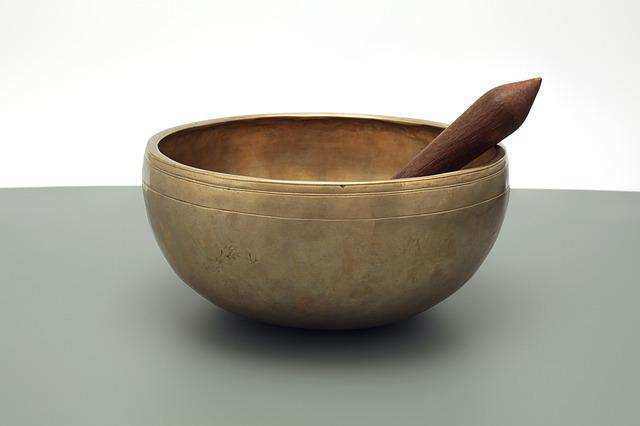
The singing bowl meditation technique explores Himalayan bowls, which produce a rich, deep music-like tone on vibration while being played. These singing bowls are more than just musical instruments; they’re tools with incredible spiritual and healing properties.
Tibetan Buddhists have used vibration and sound since ancient times in meditation sessions to help them reach a deeper level of consciousness- something we can all benefit from!
These bowls come in various sizes (larger, small, or medium-sized) and types depending on the tone (lower or deeper), frequency, chakra note, etc.
When choosing the suitable bowl to use: it is essential to understand the exact variation of your needs. In this article, we will discuss the various types of singing bowls available and their unique features.
JAMBATI BOWLS

Jambati singing bowls are an ancient Indian symbol of peace and balance. They have been used for centuries to help practitioners reach a meditative state, cultivate mindfulness in everyday life or heal the body’s ills with sound therapy! The bowls were created by hand from woolen materials such as leather stretched over dried bamboo frames, creating their unique shape – including inward-facing lips at bottom corners and curved walls. This bowl has been prized for its classical etching lines on the outside rim, as well as circular markings at the bottom inside, which get worn off when used often; hence ancient Jambati bowls have no lines.
The weight of these bowls makes them perfect to be played with mallets as they are very large. They generally play 2nd or 3rd octave, but their range extends up to four different tones, each taking on any note within reason (C-D). The Jambati bowls are the heaviest of all-singing bowl types, with about 2-4 individuals required to forge one bowl. They are also quite expensive at about $600 -$8000 per piece!
THADOBATI BOWLS
Thadobati singing bowls are the most popular type of Bowl in Asia. They have a high wall, flat bottom, and straight sides with no decoration on their lips which respond well when played by mallets or fingers. These bowls have different decorative markings with their bottom diameter slightly smaller than their opening diameter. They are usually about 5 inches deep and 8-10 inches. Some Thadobati bowls have punched and etched decorative markings making them look beautiful. The tone of the Thadobati can range over four octaves. Thick small bowls go up to 6th notes while larger, thinner ones can reach 3rd positions in an instrument’s scale! Depending on their size and quality rating, they cost around $50 – $600.
MANIPURI BOWLS
The Manipuri singing bowls have a special place in the hearts and minds of many people. They are small or medium-sized, with shallow insides that create primary tones perfect for beginners to learn on them!
The name Manipuri comes from the Northeastern state of India, which is a center for brass objects. These bowls were extensively used and led to thick etched ones turned into thin smooth ones with no markings on them; they’re so nicely made! The hammers mark shows up well in some ancient pieces too – as a test for authenticity – you can tell these weren’t just any old production run because there are fine details present here that wouldn’t survive an item being mass-produced by someone else.
They come in different sizes and thicknesses, but they all have the same tone qualities – an exquisite sound quality! These singing bowl-like instruments can be found anywhere between $50 – $400 depending on the size, quality, and skill level required when playing them (the lower second octaves will cost less).
NAGA OR PEDESTAL BOWLS
The Naga or Pedestal singing bowls are a type of chalice-like bells that have been used in ancient India to create music for meditation. These particular types can be responsive but tend not to hold their sound as well due to the loose base and thin walls, making them less ideal when you want deep tones from your bellowing instrument! The size of a bowl affects its range, as well. The Naga bowls are usually thin (in thickness) and small about 4 – 10 inches in diameter, but some older ones can be quite thick.
Naga bowls are ancient, intricately designed ceramic containers with a ceremonial or sacred purpose. These vessels were found in excellent condition and it is believed that they used these as offerings due to their pedestal design feature on some of the older pieces which appears similar enough to an offering bowl. A few inscriptions on these pieces indicate they may have been employed for sacred ceremonies. Their price range varies depending on condition; those in good shape can go anywhere between $150 – 600!
ULTABATI BOWLS
The sound of an Ultabaati bowl is different than other bowls. It can produce low notes, often used in Buddhist practice to meditate on hermit life, or fountains that symbolize flowing water to indicate calmness and peace. These singing bowls are similar to Jambati bowls; however, they have a distinctive curved side under the rim. The shape makes them less common than other types of ulta-batoas with better sound quality, and more prominent hammer marks on most pieces due to their large size over 7 inches tall by 5 inches wide rims which can come either black or bright inside depending upon how old it might be without any etching lines present as well.
The Ultabati bowl is a luxurious and expensive choice, but it will last you for years. You can buy one to match your budget for $700 – $2000.
LINGAM BOWLS
There is an oddball shape in the lingam bowl that gives it its unique sound. This instrument has a protrusion in the center with two flat ends and a navel-like bottom made from this unique structure. They have a unique sound due to their protrusion in the center which makes it difficult, but rewarding when you finally master them!
Lingam is a stylized form of Shiva, the Hindu god. It’s used in rituals and medicinal purposes to help heal ill persons. The ancient lingam bowls have a distinct rounded style, similar to Jambati. The lingam feature can also be incorporated into other bowl styles, including Manipuri and some Hindu rituals like Yagna. A genuine old metal part must be present at the bottom of this type for its strong base – these different types are highly valued among collectors with their concentric ring design that is centuries old.
The authentic, modern bowl will have thinner metal and discoloration. Medium-sized Lingam bowls are quite rare; they cost around $400 – $2000 depending on the intricacy of the design. Buyers should always ensure that what’s being sold as a “Lingam” is made of this material before buying!
REMUNA BOWLS
The Remuna singing bowls are similar to Thadobati in shape and timbre. Since they have a similar sound, mixing them with your same type of set will be seamless! Their difference is the inward sloping walls on its bottom side and flat bottom surfaces for Remuna bowls. They are also thinner than Thadobati and it is rare to see a very thick Remuna bowl.
The bowls of Remuna have a complex yet elegant style. They often have deep etching with circles inside and out and on the bottom half where there can be two textures: one for decoration which is smoother than what you find outside. This type will also sometimes include inscriptions or other markings that show off its age in years since it’s been used heavily by people all over who prized these songs’ treasures passed down through generations before them!
Remuna singing bowls are some of the most beautiful in existence, but they wear down quickly and can be costly to replace. The prices vary depending on which type you purchase- from around $200 for a basic model to $800 for premium antique models.
CONCLUSION
Choosing the right singing bowl for your meditation depends on your budget, desire, and requirements. Some people might find attractive bowls like the Remuna as their number choice or a more effective plain Manipuri bowl. If you are still uncertain about your choice, maybe a personalized recommendation from your instructor will go a long way in picking the right bowl.




